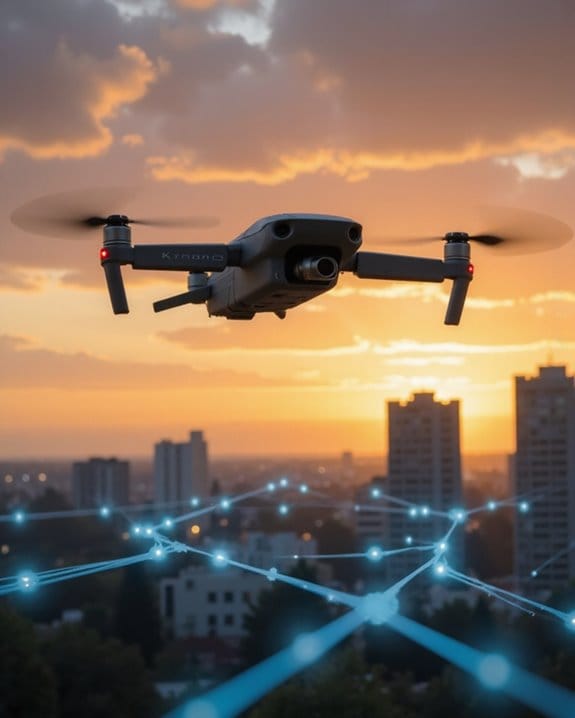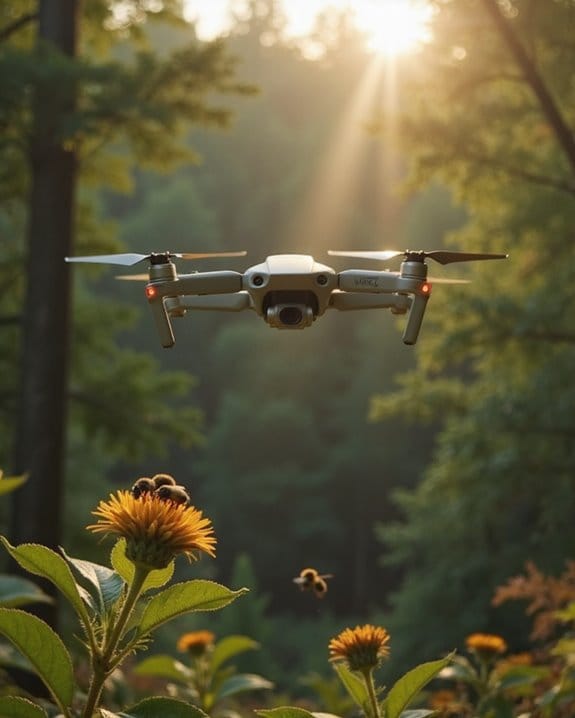You might expect Russia to use drones everywhere, but several snags hold them back. Their drones depend heavily on foreign parts—mostly Chinese and Belarusian—which are hit by sanctions and shortages. Ukraine’s powerful electronic warfare jams Russian UAVs, sidelining over half in contested areas. Russia’s fiber-optic drones solve jamming but slow down and don’t scale easily. While there’s big talk about mass production, real-world limits—tech, supply, and battlefield disruption—mean the UAV swarm remains more hype than reality. Stick around for specifics and surprising workarounds.
Key Takeaways
- Russian drones are highly vulnerable to Ukrainian electronic warfare, which jams signals and disables over half of traditional drone missions in contested areas.
- Mass production is hampered by reliance on foreign components, such as Chinese electronics and Belarusian microchips, creating supply chain bottlenecks.
- Heavy dependence on imported technology exposes Russia to risks from international sanctions and shifting policies, threatening drone availability.
- Fibre-optic drones resist jamming but are slower, heavier, and limited by cable length, reducing their operational flexibility and scalability.
- Russia prioritizes quantity over innovation, but integration and effectiveness of drones remain constrained by technical, logistical, and battlefield challenges.
Evolution of Russia’s Drone Program
A historical lens reveals that Russia’s drone program didn’t just appear overnight—it’s been shaped by successive conflicts and evolving military needs. You can trace its roots to the 2008 Russo-Georgian war, where reconnaissance drones were first adopted to fill intelligence gaps. Fast forward to the Donbas conflict, and you’ll see a shift: drones became essential for artillery targeting. The 2022 Ukraine invasion pushed Russia’s drone technology to new levels. Rapidly acquiring Shahed drones’ design documentation from Iran, Russia’s state enterprises ramped up production, aiming for 1.3 million units by 2024.
Key Features of Russia’s Drone Evolution:
- Reconnaissance drones for early battlefield awareness
- Integration of Shahed drone technology for strike capacity
- Scaled production of Zala and Lancet for operational flexibility
Different models suit varying missions, maximizing battlefield adaptability.
Obstacles Posed by Electronic Warfare
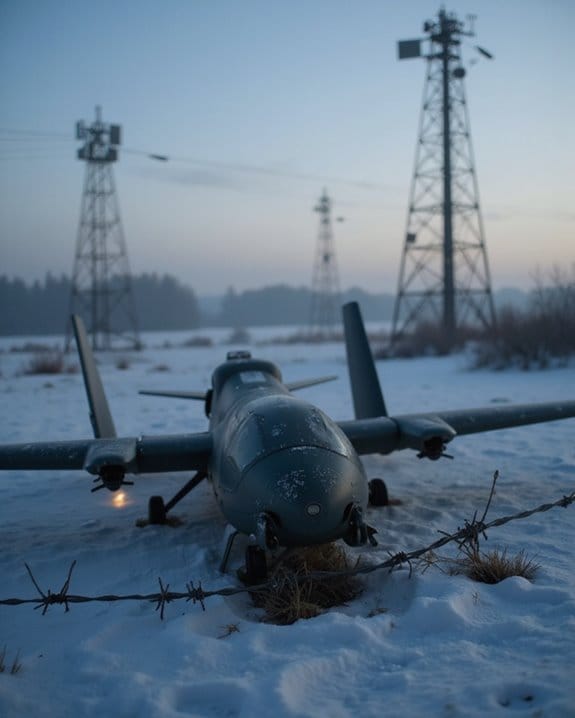
When you look at Russia’s drone operations, it’s impossible to ignore the elephant in the room: electronic warfare (EW). Ukrainian electronic warfare systems are a formidable barrier, jamming radio signals and disrupting control—especially for FPV drones. In places like Kursk, Russian bloggers highlight how intense EW jamming disables many drones, forcing a pivot to unconventional solutions.
Product Overview:
- Standard FPV drones: Agile, but highly vulnerable to EW jamming
- Fibre-optic drones (e.g., KVN models): Resist EW, but heavier and slower
Detailed Analysis:
- Over half of traditional drones can be neutralized in jammed zones
- Fibre-optic lines avoid radio detection but constrain drone speed and manoeuvrability
Recommendation:
If you’re operating in heavy EW environments, fibre-optic drones offer resilience, but expect trade-offs in performance and scalability. Additionally, understanding drone jammer key features such as frequency bands and power sources is crucial for developing countermeasures and adapting drone usage effectively.
Limitations in Russian Drone Technology
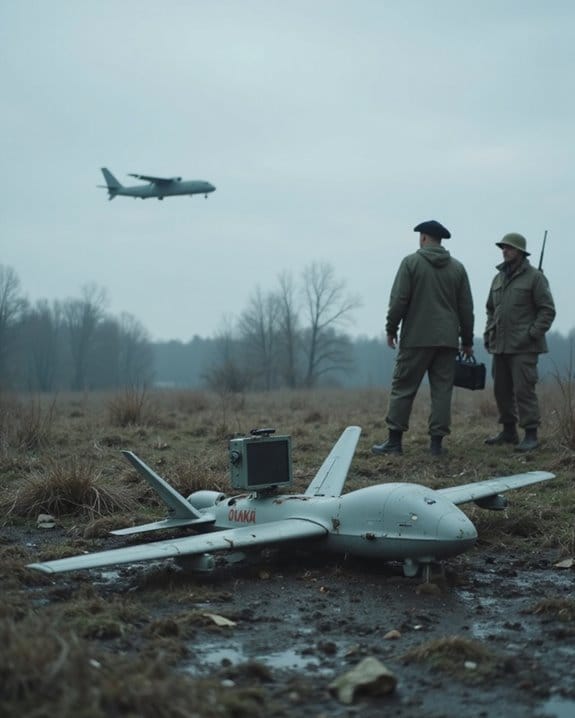
So, what’s really holding back Russian drone operations beyond the chaos of electronic warfare? It comes down to limitations in Russian drone technology, especially with FPV models. Let’s break it down:
Product Overview:
- Standard Russian FPV drones depend on radio signals for control and video feeds.
- In heavy EW environments, these radio signals are easily jammed, making drones unreliable and short-ranged.
Detailed Analysis:
- Russian modifications, like adding fibre-optic cables, avoid jamming but add up to 1.5 kg—slowing drones and reducing payloads.
- Compared to unmodified FPVs, you lose both speed and explosive punch. Not exactly a winning upgrade.
Recommendations:
- If you’re operating in contested EW zones, don’t rely solely on radio-controlled FPVs.
- Consider hybrid approaches but weigh the trade-offs: increased survivability versus reduced effectiveness. Sometimes, less really is less.
Furthermore, advanced anti-drone devices often use frequency jamming and GPS disruption to counteract such radio-controlled drones effectively.
Supply Chain and Production Challenges

Ever wonder why Russian drone fleets aren’t flooding the skies despite all the headlines? The answer lies in Russia using drones that depend on a tangled web of international suppliers. Let’s break it down:
Key Supply Chain Hurdles:
- Foreign Components: Most Russian first-person-view (FPV) drones rely on Chinese engines and flight controllers. A single export restriction could ground production.
- Sanctions: Even with Iranian designs like the Shahed, importing parts is tough due to global sanctions.
- Belarusian Bottlenecks: Microelectronics from Belarus are vital, so any hiccup there halts assembly lines.
- Mass Production Woes: Ambitious goals—like making 1.3 million drones—hit roadblocks when bulk imports face geopolitical turbulence.
If you’re analyzing Russia using drones, consider how these vulnerabilities impact both reliability and scalability. Supply chains aren’t just lines—they’re lifelines. Additionally, choosing drones with payload capacity and operational capabilities suited to mission needs is critical for overcoming these challenges.
Strategic Priorities and Deployment Choices
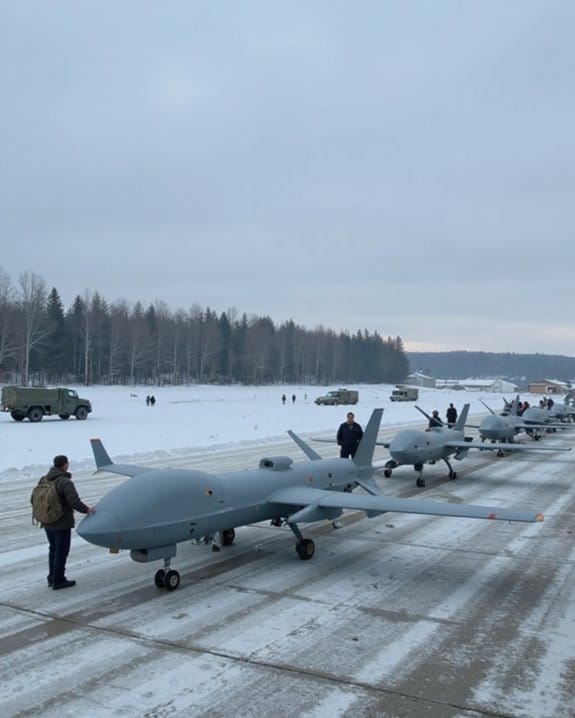
Supply chain vulnerabilities aren’t the only reason Russia’s drone playbook looks different from what you might expect. Strategic priorities shape deployment choices in modern drone warfare. Rather than spreading resources thin, Russia aims to overwhelm Ukrainian defenses with mass-produced Shahed drones—sometimes launching nearly 100 per night. Let’s break down how this plays out:
Key Deployment Choices:
- Kursk Region Focus: Here, Russia relies on fiber-optic drones to counter electronic warfare (EW) jamming, trading agility for reliability.
- Quantity Over Quality: The goal is 1.3 million drones in 2024, favoring cost-effective swarms over high-tech innovation.
- Tactical Integration: Drones support artillery and reconnaissance, not universal front-line use.
- Import Reliance: Choices are shaped by parts from Iran and China.
If you’re seeking innovation, Russia’s strategy prioritizes volume and tactical impact.
Impact of Ukrainian Countermeasures
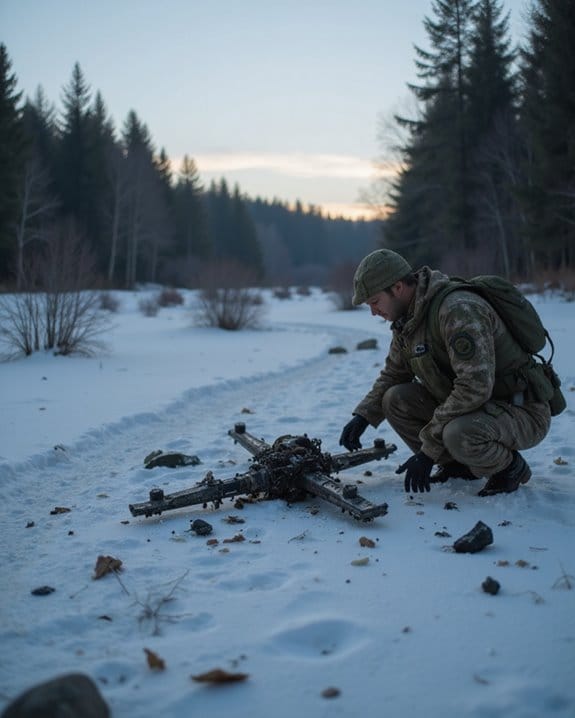
How have Ukrainian defenses managed to blunt Russia’s drone ambitions? The answer lies in Ukraine’s mastery of electronic warfare (EW) and clever tactical adaptations. Let’s break down the impact:
Key Ukrainian Countermeasures:
- Electronic Warfare (EW): Ukrainian EW systems jam radio signals controlling Russian drones, especially in hotspots like Kursk. This has rendered traditional UAVs, including FPV drones, largely unreliable.
- Interceptor Drones: Ukraine deploys specialized drones that neutralize Russian UAVs mid-air, reducing the effectiveness of drone attacks.
- Advanced Jamming: Sophisticated jamming technology forces Russia to explore fiber-optic drones, since radio-controlled models keep getting disrupted.
Bottom line: If you’re Russia, facing Ukrainian EW means over half your attempted drone missions might fail, sharply limiting the scale and impact of your drone attacks.
Comparative Analysis: Russian vs. Ukrainian Drone Strategies
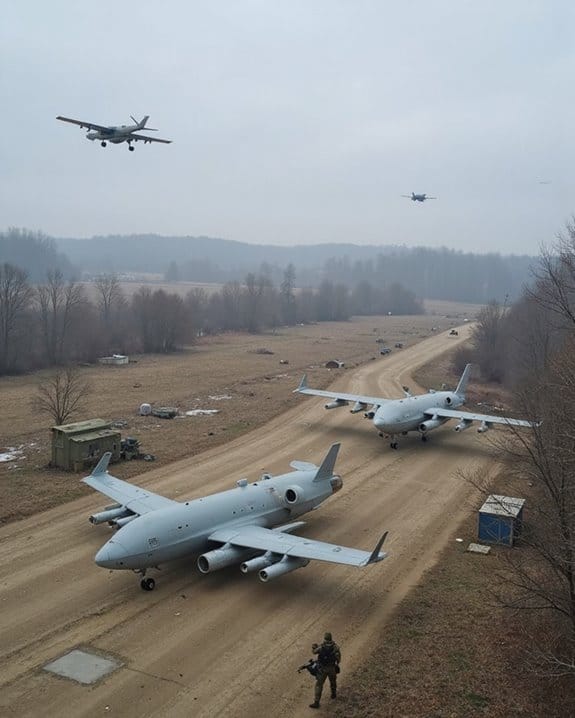
While both Russia and Ukraine have turned drones into essential battlefield tools, their strategic approaches couldn’t be more different.
Overview
- Russia: Mass production, overwhelming numbers—think 1,000 Shahed drones monthly and massive nightly barrages.
- Ukraine: Precision and innovation—fewer drones per night, but each Ukrainian drone is optimized for targeted strikes.
Detailed Analysis
- Russia’s first-person-view (FPV) drones often rely on imported parts and state-controlled manufacturing, aiming for sheer volume. However, these UAVs are vulnerable to electronic warfare (EW), which Ukraine exploits.
- Ukraine, meanwhile, invests in EW-resistant FPVs, leveraging private-sector tech and international support to outmaneuver Russian defenses.
Recommendations
- If you value quantity and brute force, Russia’s approach stands out.
- For tactical effectiveness and resilience against EW, Ukraine’s advanced, precision-driven drone strategy is the clear choice.
The Role of International Partnerships

Curious what’s really powering Russia’s drone surge? It’s not just homegrown ingenuity—you’ll find a web of international partnerships fueling the current drone war in the Russia-Ukraine war.
Key International Inputs:
- Iran: Russia’s mass production of Shahed drones relies on Iranian blueprints. This enables high-volume output but limits independent innovation.
- China: Critical components—like engines and controllers for FPV drones—come from China, putting Russian surveillance efforts at the mercy of supply chain politics.
- Belarus: Manufacturing deals streamline production, reaching up to 1,000 Shahed drones monthly.
Bottom Line:
These alliances give Russia access to key tech—think fibre-optic drones—but heavy dependence on foreign partners means sanctions or policy shifts could ground drone operations fast. For sustainable drone use, Russia must balance partnership perks with autonomy.
Tactical Shifts in the Battlefield
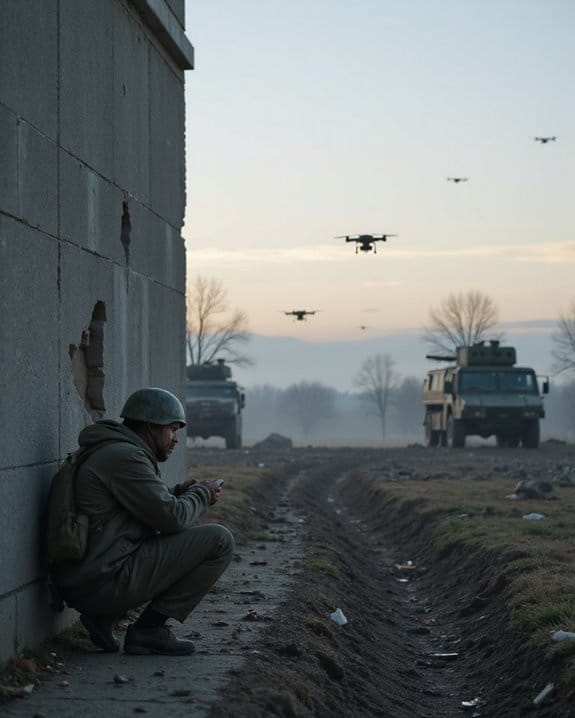
Adaptability has become Russia’s signature move on the battlefield, especially as Ukrainian electronic warfare (EW) units ramp up their jamming tactics. On the front line, you’ll notice Russia is moving away from mass radio-controlled drones and instead deploying fiber-optic models. Why? Because electronic warfare is wreaking havoc on standard drones, making them unreliable in jammed zones.
Product Overview:
- KVN Fiber-Optic Drone:
- Jam-proof, using up to 10.8 km of cable
- Immune to front line EW jamming
- Limited by cable length and deployment complexity
Detailed Analysis:
- Traditional drones: easy deployment, high vulnerability
- Fiber-optic variants: robust under EW, slower operations
Recommendations:
- Use fiber-optic drones for high-risk, jammed sectors
- Reserve radio-controlled drones for less-contested areas
Sometimes, the best connection isn’t wireless!
Future Prospects for Russian Drone Warfare
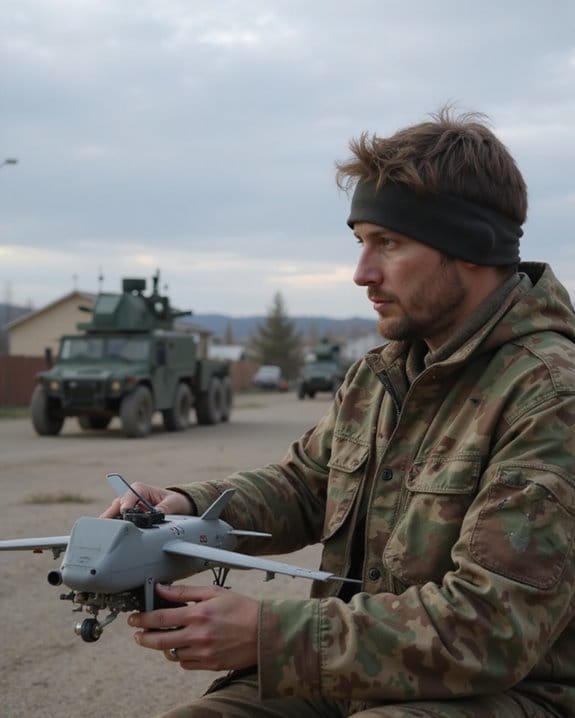
Looking ahead, Russia’s drone playbook is set for a major expansion. You’ll see a surge in drone strikes as Russia plans to produce up to 1.3 million aerial vehicles in 2024, including different types like the Iranian Shahed and new fiber-optic models. Here’s what stands out:
Product Overview:
- Mass production: 1.3 million units projected
- Simultaneous attacks: Up to 500 UAVs at once
- Fiber-optic drones: 3,000 units/month if successful
Detailed Analysis:
- These new drones resist electronic warfare, bypassing jamming.
- Different types offer tactical flexibility—some for surveillance, others for direct strikes.
Recommendations:
- Expect drone warfare to shift toward quantity and technological diversity.
- For those countering Russian drones, focus on innovations against fiber-optic guidance.
After all, when drones multiply, so do the headaches.
Frequently Asked Questions
Where Does Russia Get Its Drones From?
Think of Russia’s drone supply as a web—you’re seeing strands from Iran, China, and Belarus weaving together. Russia imports Shahed drones, uses Chinese parts for FPVs, and builds models like Zala and Lancet domestically.
Does Russia Have an Anti-Drone System?
Yes, Russia’s got robust anti-drone systems. You’ll find they’re using advanced electronic warfare to jam and disable enemy drones, especially in hotspots like Kursk. These systems give Russia a strong defensive advantage against UAV threats.
How Effective Are Shahed Drones?
You’ll find Shahed drones highly effective—they’re cheap, hard to stop, and can swarm defenses with sheer numbers. If you’re defending, you’ll struggle as these drones overwhelm your resources and damage critical infrastructure night after night.
Are Drones Illegal in Russia?
You’d think drones would be forbidden fruit in Russia, but they’re not just legal—they’re practically the government’s favorite toy. You’ll see state factories churning them out, military units flying them, all fully sanctioned and authorized.


